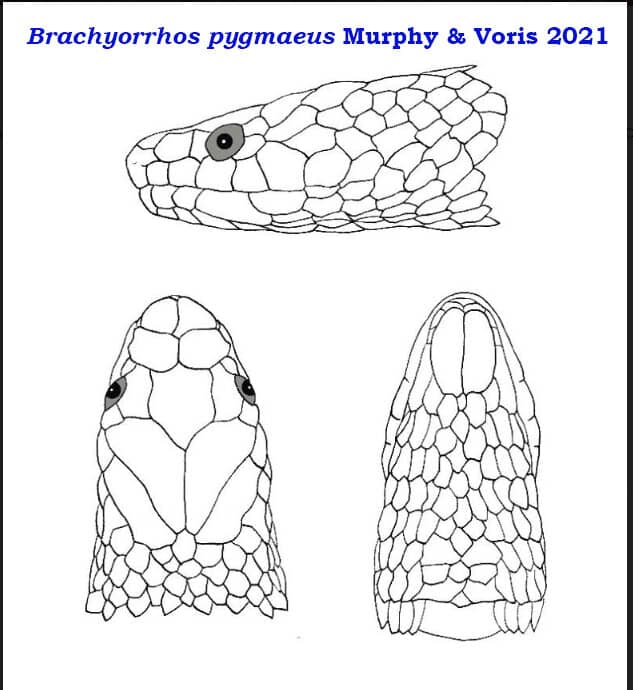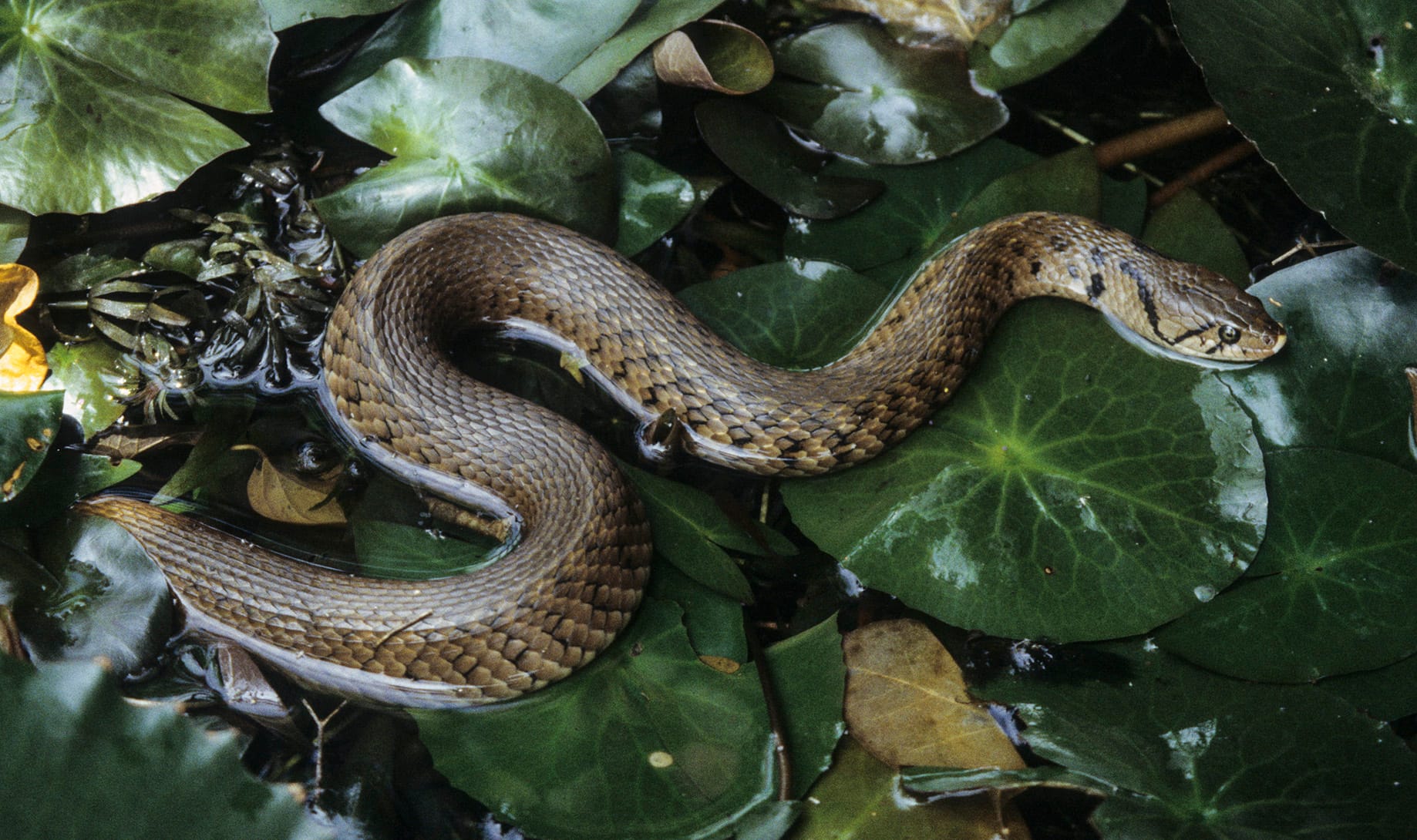The Barbados Threadsnake, (Tetracheilostoma carlae), is considered the world’s smallest snake. It is tiny – reaching a maximum adult length of only 104 mm (4.1 inches) and an average weight of 0.6 g (0.02 ounce). Described by Hedges (2008), it is a member of the ancient clade Leptotyphlopidae commonly referred to as threadsnakes. Threadsnakes, Blindsnakes (Typhlopidae), and the Dawn Snakes (Anomalepididae) are all ancient lineages that have adapted to a subterranean existence and feed primarily on social insects (ants and termites). The lifestyle and diet would suggest that these should be some of the smallest snakes so they can enter the social insect nests – ant mounds and termitary.
The Alethinophidia is a clade of snakes that includes all snakes except the threadsnakes, blindsnakes, and dawn snakes. Alethinophidians are sometimes referred to as advanced snakes. Numerous candidate species compete for the title, smallest advanced snake.
The smallest snakes are in the scoleocophidian family Leptotyphlopidae and the smallest known snake is the threadsnake Tetracheilostoma carlae (Hedges, 2008) from Barbados (West Indies). The largest known adult is 104 mm. Six leptotyphlopid species have maximum lengths that are less than 105 mm; four are known only from their holotypes (Hedges 2008). However, as Hedges (2008) noted, as species become better known and the number of specimens increases, the maximum size also increases.
Within the alethinophidian snakes, a few species in several lineages approach the diminutive size seen in the threadsnakes and blindsnakes. The highly specialized shield-tailed snakes (Uropletidae) include Uropeltis petersi, a species known to reach 190 mm in total length, but it is known from only six specimens. There are many small, fossorial colubroid snakes in the 200-–300 mm total length range. Within the Colubroidea, Inger & Marx (1965) listed 41 species of dwarf reed snakes in the genus Calamaria (Colubridae). Of those, only five species did not exceed 200 mm; and all were represented by less than three individuals. Recently, Koch et al. (2018) described Calamaria banggaiensis that has a total length of 199 mm. There are several tiny black-headed snakes in the genus Tantilla. Savage (2002) reports Tantilla vermiformis reaches a maximum total length of 157 mm, and it is well represented in collections. The Australian elapid, Simoselaps anomalus reaches a maximum of 210 mm total length, and S. minimus reaches 219 mm (Clarke & How 1995). In the family Dipsadidae, the Middle American Geophis bellus is 210 mm in total length (Myers 2003). Passos et al. (2009a) described Atractus multidentatus based upon a single adult female that was 172 mm in total length from Venezuela’s Cordillera de Mérida; later, Passos et al. (2009b) described Atractus avernus based upon a single specimen that was 177 mm in total length. Both species may eventually be found to exceed 200 mm. The Malagasy Pseudoxyrhopus kely (Lamprophiidae) has a maximum length of 217 mm. The smallest viper is Bitis schneideri (Boettger, 1886) at 260 mm maximum length (Mallow et al. 2003). Thus, the smallest, best documented alethinophidian snake is likely Tantilla vermiformis at 157 mm.
In a new paper, Harold Voris and I describe Brachyorrhos pygmaeus (Homalopsidae) from the island of Seram. The snake had been collected in 1909 by Wilfred Stalker. Stalker’s snake was discovered by us while examining Brachyorrhos at the Natural History Museum (NHM), formerly the BMNH. I (JCM) collected data on the small Brachyorrhos specimen (BMNH 1910.4.26.60) that Samuel McDowell had previously examined and noted that it contained mature ovarian eggs.
Brachyorrhos are the only homalopsid snakes known to have bilobed nasal scales separated by the rostral; a divided internasal positioned posterior and dorsal. The members of the genus are distinguished from Calamophis by the lack of dorsal scale row reduction (Brachyorrhos has 19-19-19, Calamophis has 19-19-17); dorsal scales that are ovate, slightly imbricate or juxtaposed compared to dorsal scales in Calamophis. Brachyorrhos has a divided nasal scale, and a tail that lacks a constriction at its base and tapers gradually to the tip. Given the morphological evidence, we described BMNH 1910.4.26.60 as the fifth species in the genus Brachyorrhos.
For a perspective on the relationship on the differences in size we measured several near-term embryos of Brachyorrhos albus, which ranged from 136 to 147 mm in total length. Based on McDowell’s notation accompanying BMNH 1910.4.26.60, B. pygmaeus contained mature ovarian eggs and is therefore sexually mature at a total length of 128 mm, 6-9 mm less than a B. albus embryo. The exceptionally small size of Brachyorrhos pygmaeus makes it a candidate for the world’s smallest alethinophidian snake.
References
Hedges SB. 2008. At the lower size limit in snakes: two new species of threadsnakes (Squamata: Leptotyphlopidae: Leptotyphlops) from the Lesser Antilles. Zootaxa. 1841: 1–30. doi:10.11646/zootaxa.1841.1.1
Murphy JC & HK Voris. 2021. A new species of Brachyorrhos from Seram, Indonesia and notes on fangless homalopsids. Philippine Journal of Systematic Biology, 14(2)













